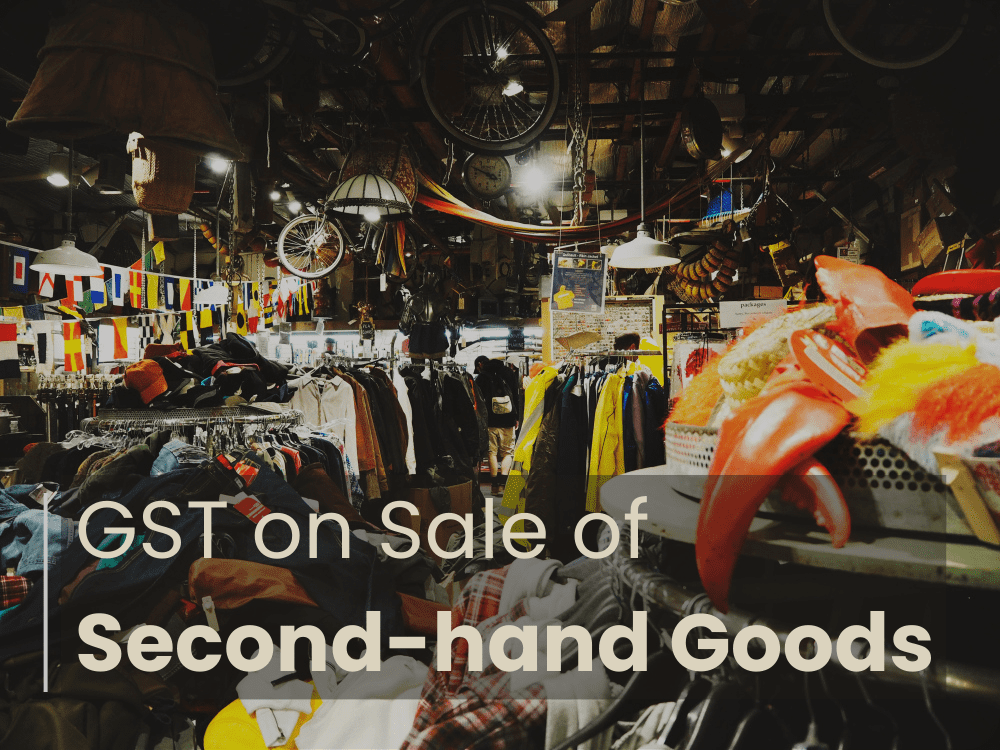
If you are planning to sell your old household goods, used car or furniture, you might be wondering whether you need to pay GST on such transactions.
The determination of the applicable GST rate relies on multiple factors, including the characteristics of the goods, the transaction’s value, the status of the seller and buyer, and whether the seller has availed input tax credit (ITC) for the purchase of said goods.
Is GST Applicable on the Sale of Second-hand Goods
GST extends to the transaction of selling second-hand goods, such as used household items, furniture, and pre-owned vehicles, among others. In accordance with the GST framework, the sale of second-hand goods is regarded as a taxable supply, thus subject to the levy of GST.
Under the provisions of the GST law, an individual selling second-hand goods is recognised as a supplier and is obligated to impose and collect GST from the purchaser. The specific rate of GST applicable will vary based on the type of goods being sold.
However, there are rules to the GST applicability on sales of used goods.
Rules of Applicability
Margin Scheme:
Under the GST regime, the Margin Scheme is a special provision that applies to the sale of second-hand goods. Here are the key features of the Margin Scheme:
- Applicability: The Margin Scheme is applicable when a registered dealer sells second-hand goods, including used vehicles, machinery, furniture, etc.
- Calculation of GST: Under the Margin Scheme, GST is levied only on the margin or the difference between the selling price and the purchase price of the second-hand goods. The GST is not charged on the full selling price.
- Exclusion of Input Tax Credit (ITC): Sellers who opt for the Margin Scheme are not eligible to claim Input Tax Credit on the purchase of second-hand goods. This means they cannot offset the GST paid on the purchase against the GST collected on their sales.
- Change in Shape or Nature: If the shape or nature of second-hand goods is changed during maintenance, repair, or similar processes, the Margin Scheme is invalidated. In such cases, GST is applicable on the full taxable value of the goods, calculated based on the selling price, regardless of the purchase price or margin.
- No GST on Intermediaries: If a person acts as an intermediary for the sale of second-hand goods (i.e., acts as a commission agent, broker, or auctioneer), the ‘Margin Scheme’ does not apply to them. In this scenario, the dealer would be responsible for paying GST at a rate of 18% on the commission earned, provided that their turnover exceeds the threshold.
It’s important to note that the Margin Scheme is an option available to registered dealers, and it is not mandatory. Dealers can choose to apply the Margin Scheme or opt for the regular GST provisions, depending on their business requirements.
Exemption for Individuals:
GST provides an exemption for individuals engaged in the sale of their own personal used goods, aiming to alleviate GST responsibilities for infrequent and non-commercial transactions. The essentials of this exemption are:
- Personal Used Goods: The exemption applies to individuals who sell their own personal used goods, such as clothes, furniture, electronic appliances, and other personal items.
- Non-Business Activity: The exemption is applicable when the sale of used goods is not part of a business or commercial activity. It is meant for occasional or one-time sales by individuals for their personal purposes.
- No GST Liability: Individuals selling their own personal used goods are generally not required to charge and collect GST on these sales. They are not liable to pay GST on the sale proceeds.
Dealer or Registered Person:
Under the GST regime in India, if a person is a dealer or a registered person engaged in the business of selling second-hand goods, specific rules apply:
- Registration: If a person is engaged in the business of selling second-hand goods, they are required to register for GST if their annual turnover exceeds the threshold specified by the government. It is mandatory for such businesses to obtain GST registration.
- GST Liability: Registered dealers or persons selling second-hand goods are liable to charge and collect GST from their customers on the sale of these goods. The applicable GST rate will depend on the category of goods being sold.
- ITC: Registered dealers or persons can claim Input Tax Credit on the GST paid on the purchase of second-hand goods, provided they have not opted for the margin scheme, and are complying with the necessary conditions and fulfilling other requirements as per GST laws.
- GST Returns: Dealers or registered persons selling second-hand goods need to file regular GST returns, such as GSTR-1 (outward supplies), GSTR-3B (summary return), and annual return (GSTR-9 or GSTR-9C). These returns help in reporting the sales made and the GST collected.
- Compliance and Documentation: Registered dealers or persons selling second-hand goods need to maintain proper records and documents related to their sales, purchases, and GST payments. They are also required to issue GST-compliant invoices or bills to their customers.
As per the rules of GST on transaction of used goods the rates are the same as those of new goods. For example, if you paid 18% for purchasing a new good the GST rate will be 18% on its resale price, provided the above conditions are met. However, this GST rate rule doesn’t apply to the sale of used cars.
GST rates on used cars in India were initially the same as those for new cars but were later reduced to boost the sale of second-hand cars. Currently, the GST rate for small petrol cars with an engine size up to 1200cc and diesel cars up to 1500cc is 12%. For petrol cars with an engine size larger than 1200cc and diesel cars larger than 1500cc, the GST rate is 18%. The GST on used cars is calculated based on the margin of supply value. There are specific scenarios where tax liability may vary, such as when a used vehicle is sold by the government or in cases where a businessperson’s turnover is below the exemption limit.
GST on Upcycling Goods Exceeding Threshold
The act of upcycling involves converting discarded or unwanted items into new products that have improved quality or environmental value. It is a recycling method that contributes to reducing plastic waste in the environment. However, the practice of upcycling may also have implications concerning the Goods and Services Tax in India.
GST law mandates registering under GST for any individual or business involved in commercial activities with an aggregate turnover surpassing Rs. 20 lakhs (or Rs. 10 lakhs for special category states). They must also pay taxes on the supplies that are taxable. Aggregate turnover encompasses the combined value of all taxable supplies, exempt supplies, exports of goods and/or services, and inter-state supplies made by a person with the same PAN (Permanent Account Number). This calculation is conducted on an all-India basis.
Therefore, if a person is upcycling old goods and selling them as new products, they may have to pay GST if the aggregate turnover of such supplies exceeds Rs. 20 lahks in a financial year. The GST rate will depend on the nature and classification of the new products. For example, if the old goods are upcycled into handicrafts, then the GST rate may be 12% or 18% depending on whether they are made predominantly by hand or by machine.
GST’s complex structure may appear tricky and overwhelming to a non-professional. Therefore, if you are looking for a comprehensive understanding of the GST rules on the sale of second-hand goods for personal or business intentions, it’s important to consult a tax professional.
FAQ
What is the GST on sale of second-hand assets?
Yes. There is no exemption for purchase of second-hand goods from a registered person and hence the supplier has to pay GST as per the tax invoice received from the registered person.
What is the GST rate for second-hand clothes?
Under GST, worn clothing is classified under the category of used or second-hand goods. The GST rate for used or second-hand clothing is 18% on the value of supply.
What is the GST rate on old wood furniture?
A GST rate of 12% is applicable to wood and wood-based furniture.
Have Any Question?
- (+91) 9899020497




